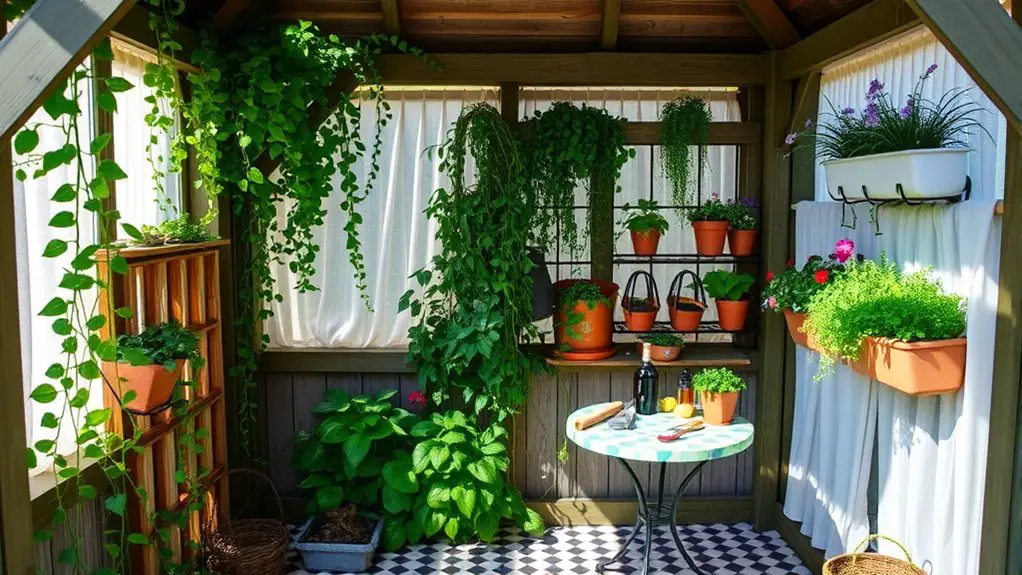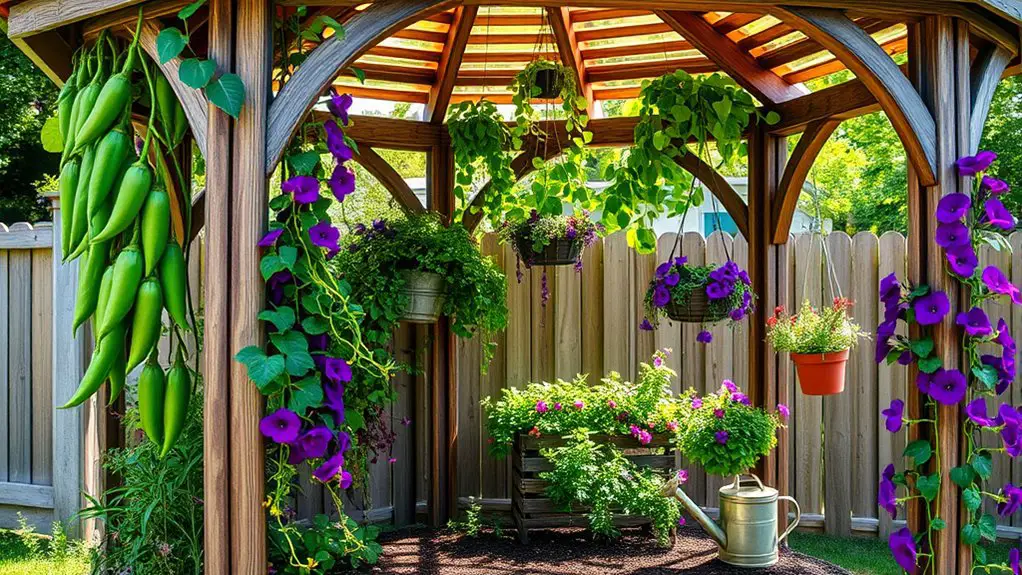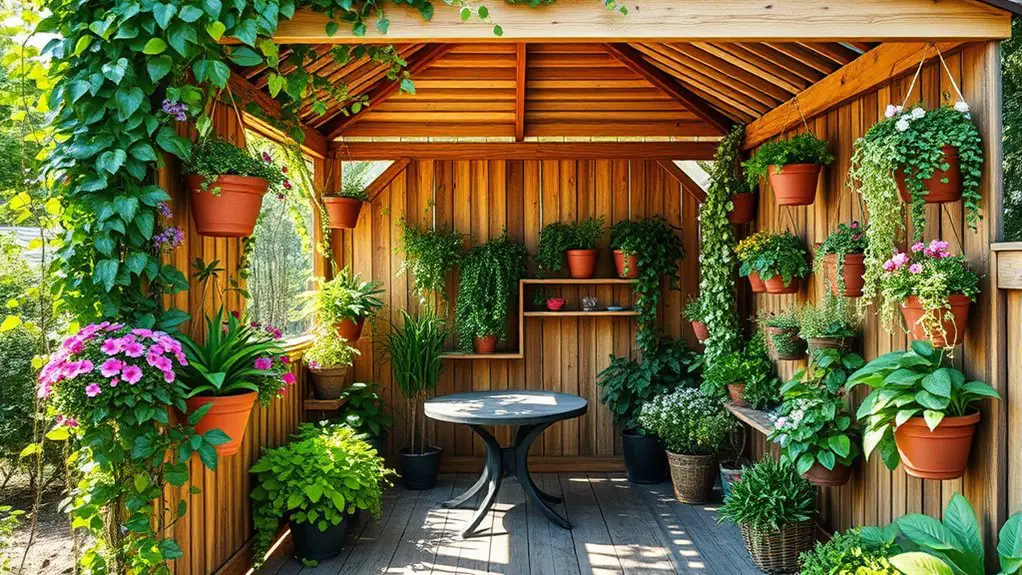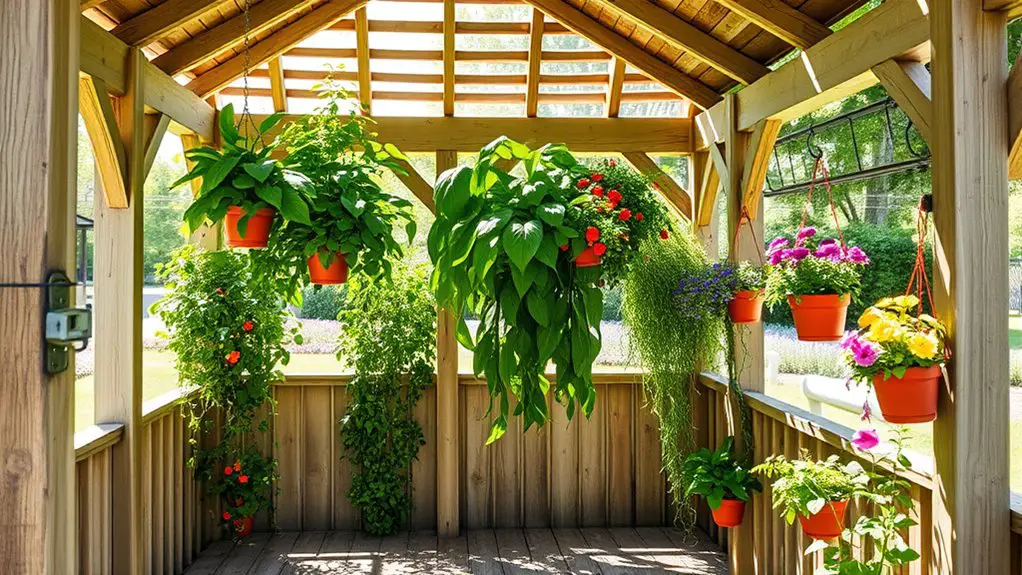To use vertical gardening in your small gazebo, start by selecting a south-facing location that receives 6-8 hours of sunlight. Choose climbing plants like pole beans or flowering vines that thrive on vertical support. Utilize trellis systems for stability and maximize your growing area with modular planting solutions. Regularly monitor plant health, water efficiently with drip systems, and adapt your garden for seasonal changes. There’s more effective strategies to create a lush vertical oasis in limited space.
Understanding Vertical Gardening Basics

While you might think vertical gardening is just a trendy way to beautify small spaces, it’s actually a practical solution for maximizing limited gardening areas. By utilizing vertical space, you can grow a variety of plants, from herbs to flowers, without sacrificing your ground area. One of the primary vertical gardening benefits is increased yield per square foot, allowing you to enjoy more produce in a compact environment.
However, there are vertical gardening challenges to take into account. Ensuring proper support for climbing plants, managing water drainage, and providing adequate sunlight can complicate your gardening efforts. You’ll also need to choose the right planting medium and monitor plant health closely. By understanding these basics, you can overcome challenges and fully embrace the freedom that vertical gardening offers. With careful planning, your small gazebo can become a lush, vibrant garden that enhances both your space and your lifestyle.
Choosing the Right Location in Your Gazebo
Selecting the right location for your vertical garden within the gazebo can greatly impact plant health and growth. You’ll want to take into account factors like gazebo orientation and sunlight exposure to guarantee your plants thrive.
| Aspect | Ideal Conditions | Considerations |
|---|---|---|
| Gazebo Orientation | South-facing | Maximizes sunlight throughout the day |
| Sunlight Exposure | 6-8 hours daily | Adjust plant selection based on light availability |
| Airflow | Good circulation | Prevents mold and promotes healthy growth |
Position your vertical garden against walls that receive ample sunlight, while making sure there’s enough airflow. Avoid spots that are too shaded, as this can hinder plant growth. By strategically choosing your garden’s location, you’ll create a favorable environment for flourishing plants, giving you the freedom to enjoy your green oasis. Additionally, ensuring good circulation can enhance plant health and prevent issues like mold.
Selecting Suitable Plants for Vertical Growth

When choosing plants for vertical growth in your gazebo, it’s essential to reflect on their growth habits and suitability for upward cultivation. Opt for varieties that thrive in a vertical setup, ensuring you maximize your space effectively. Here are some excellent options to take into account:
- Climbing vegetables: Varieties like pole beans, cucumbers, and peas are perfect for vertical growth and yield abundant produce.
- Flowering vines: Think about options like sweet peas or morning glories that add vibrant color and charm.
- Herbs: Basil and rosemary can climb with support, offering both beauty and utility.
- Perennial climbers: Plants like clematis or honeysuckle can provide structure and fragrance year after year.
- Fruit-bearing vines: Grapes or kiwis can create a lush, fruitful canopy.
Vertical Gardening Structures and Systems
After choosing the right plants for your vertical garden, the next step is to implement effective structures and systems that support their growth. Vertical trellis systems are a fantastic option, providing a sturdy framework for climbing plants. These can be made from materials like wood, metal, or even repurposed items, allowing you to customize your garden’s look while ensuring durability.
For more versatility, consider modular planting solutions. These systems allow you to easily rearrange or expand your garden as needed. You can mix and match containers to suit your space, which is especially useful in a small gazebo.
Both vertical trellis systems and modular planting solutions enable you to maximize your growing area, giving your plants the freedom to thrive upward instead of outward. By selecting the right structures, you’ll create a vibrant vertical garden that enhances your gazebo’s aesthetic while remaining functional.
DIY Vertical Garden Ideas for Your Gazebo

When creating a DIY vertical garden in your gazebo, you’ve got several planter options to take into account, like wall-mounted planters or tiered shelves. Selecting the right plants is vital; think about factors such as sunlight, moisture, and growth habits to guarantee a thriving garden. By strategically combining these elements, you can maximize your space while enhancing the gazebo’s aesthetic.
Vertical Planter Options
Creating a vertical garden in your gazebo can maximize space and enhance your outdoor experience. With various vertical planter options, you can choose styles that fit your aesthetic and functional needs. Consider the following planter materials and styles:
- Wooden Pallets – Easy to find and customize.
- Metal Racks – Durable and modern; perfect for herbs.
- Hanging Planters – Utilize overhead space for trailing plants.
- Trellises – Great for climbing vegetables and flowers.
- Wall-mounted Planters – Save floor space while adding greenery.
These vertical planter styles allow you to create a lush garden while ensuring your gazebo remains a cozy retreat. With the right materials, you’ll enjoy a flourishing vertical garden that reflects your personal touch.
Plant Selection Tips
Selecting the right plants for your vertical garden is essential, as it can greatly influence both aesthetics and productivity. Start by choosing a mix of herb varieties and flowering plants to create visual interest and functional benefits. Herbs like basil, thyme, and mint thrive vertically and are great for culinary use. For flowering plants, consider cascading varieties such as petunias or nasturtiums, which add color and attract pollinators. Guarantee you select plants with similar light and water requirements to simplify care. Also, think about growth habits—some plants will climb, while others will spread. With thoughtful selection, your vertical garden will not only beautify your gazebo but also provide fresh herbs and vibrant blooms, enhancing your outdoor experience.
Maintaining Your Vertical Garden
Although maintaining your vertical garden may seem challenging, it’s crucial for guaranteeing the health and longevity of your plants. Here are some practical tips to keep your garden thriving:
Maintaining your vertical garden is essential for the health and longevity of your plants. Here are key tips to thrive.
- Regular Watering: Keep a consistent schedule to meet your plants’ moisture needs.
- Pest Management: Monitor for pests and use organic treatments to prevent infestations.
- Nutrient Requirements: Test your soil regularly and provide necessary fertilizers for peak growth.
- Pruning: Regularly trim dead or overgrown foliage to encourage new growth and improve airflow.
- Check for Support: Confirm climbing plants have adequate support and adjust as they grow.
Additionally, ensure that your vertical garden is positioned in a way that protects it from common issues like wind damage and moisture exposure.
Integrating Vertical Gardening With Gazebo Decor
When you integrate vertical gardening with gazebo decor, you not only enhance the aesthetic appeal of your outdoor space but also maximize functionality. Start by selecting decorative elements that complement your gazebo’s style, whether it’s rustic, modern, or traditional. Vertical planters can serve as living art pieces, drawing the eye and creating a focal point.
Consider color coordination; choose plants with hues that harmonize with your gazebo’s color scheme. For instance, vibrant flowers can contrast beautifully against neutral wood or metal finishes, while greenery can soften more structured designs.
Incorporate various textures through different plant types, such as cascading vines or bushy herbs, to add depth. You might also think about using trellises or wall-mounted pots to maintain an organized look. By thoughtfully merging vertical gardening with your gazebo decor, you’ll create an inviting atmosphere that encourages relaxation and enjoyment.
Maximizing Sunlight and Water Access
To maximize sunlight access in your vertical garden, consider the placement of each plant based on its light requirements. Position taller plants where they won’t overshadow shorter ones, ensuring all receive adequate light. Additionally, implementing efficient watering techniques, like drip irrigation, can help provide consistent moisture without waste.
Optimal Plant Placement
Maximizing sunlight and water access is essential for the success of your vertical garden in a small gazebo, as proper plant placement can greatly impact growth and yield. Here are some ideal plant placement strategies to take into account for maximizing vertical space:
- Top Shelves: Place sun-loving plants like tomatoes and peppers for maximum light exposure.
- Middle Layers: Use herbs, such as basil and cilantro, which benefit from filtered sunlight.
- Bottom Level: Grow shade-tolerant plants like lettuce and spinach that thrive in less light.
- Spacing: Guarantee adequate spacing for airflow and light penetration.
- Water Needs: Group plants with similar watering requirements to simplify maintenance.
Efficient Watering Techniques
While ensuring your vertical garden receives adequate sunlight, efficient watering techniques play a crucial role in maintaining plant health. Drip irrigation systems are ideal for delivering water directly to the roots, minimizing waste and evaporation. These systems allow you to customize watering schedules, ensuring your plants thrive without constant monitoring. Additionally, self-watering systems can provide consistent moisture for your vertical garden, reducing the need for daily attention. Incorporating reservoirs or wicking systems can help maintain moisture levels, promoting healthy growth. By implementing these techniques, you can enjoy the freedom of a flourishing garden without the hassle of frequent watering. Embrace these methods to maximize both sunlight and water access in your small gazebo, ensuring your plants flourish effortlessly.
Seasonal Considerations for Vertical Gardening
As you plan your vertical garden in a small gazebo, understanding seasonal considerations is crucial for successful growth and yield. Timing your seasonal plantings and making climate adaptations can maximize your garden’s potential. Here are some key points to keep in mind:
- Choose plants suited for each season: Opt for cool-season crops in spring and fall, and warm-season ones in summer.
- Monitor sunlight exposure: Seasonal changes affect light; adjust plant placement to guarantee adequate sunlight year-round.
- Manage temperature variations: Insulate your gazebo or use heating lamps to protect sensitive plants during colder months.
- Watering frequency adjustments: With changing weather patterns, adapt your watering routine to avoid over- or under-watering.
- Plan for pest control: Different seasons bring various pests; be proactive with organic pest management strategies.
Frequently Asked Questions
Can I Grow Herbs in a Vertical Garden in My Gazebo?
Sure, you can grow herbs in your vertical garden! Just remember, some herbs prefer more light than others. Choose wisely—basil and thyme thrive, while chives might sulk in the shadows. Let your garden flourish!
How Much Weight Can a Vertical Garden Structure Support?
When considering a vertical garden’s weight capacity, it’s essential to evaluate the structural materials used. Different materials have varying strengths, so make certain your setup can safely support the combined weight of plants and containers.
Are There Specific Pests to Watch for in Vertical Gardens?
In your vertical garden’s thriving ecosystem, watch for sneaky pests like aphids and spider mites. Implementing effective pest management with organic treatments guarantees your plants flourish, granting you the freedom to enjoy a bountiful harvest.
What Is the Best Soil Type for Vertical Gardening?
For vertical gardening, use a well-balanced soil composition with organic matter for nutrients. Guarantee proper drainage requirements by adding perlite or vermiculite, preventing waterlogging while promoting healthy root development and plant growth.
How Do I Prevent My Vertical Garden From Toppling Over?
Your vertical garden’s like a dancer; it needs support structures to stay graceful. Choose sturdy plants and secure them well. Reinforce your setup with trellises or brackets, ensuring everything stands tall against the elements.

